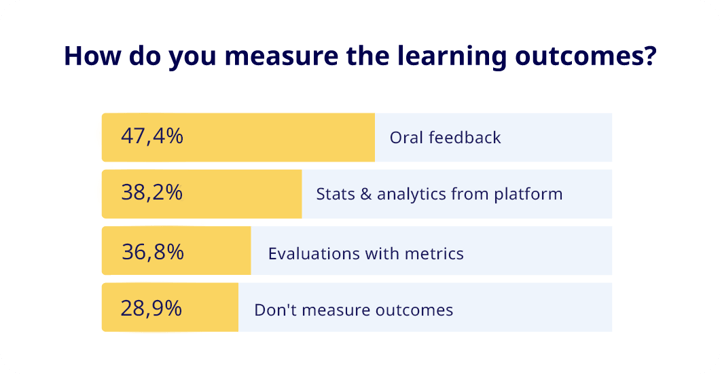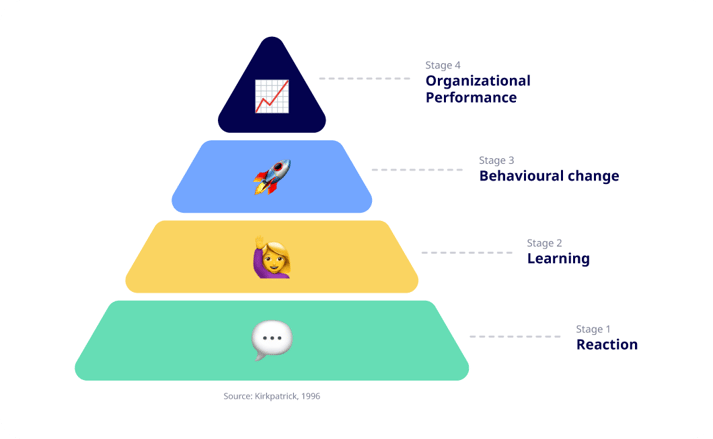Hard Numbers or Soft Feedback?
What is your argument? Do you have stats to back up the facts? What do the employees think? Questions from management can be many and varied when they want an evaluation of your training and learning initiatives.
Oral, qualitative feedback from learners and the management themselves is usually the way HR and L&D professionals in Nordic countries measure their learning outcomes (47.4%).
And it is, of course, a good idea to get feedback on the learning content. But, at the same time, getting this information, orally, is more time-consuming, than looking at the stats and analytics provided by your learning platform (if the learning content is sent out to learners this way).

The sum of it all - hard numbers or soft feedback aside - it is crucial to measure learning outcomes because it is the only way to improve and understand the impact your training has on both learners and the business as a whole.
More than 25 percent of respondents in Learningbank's Nordic Learning Trends Report 2023 do not measure the outcomes at all, and it is, of course, understandable if the process for measuring and evaluating is that time-consuming.
With the right tools, however, measuring learning outcomes can be a piece of cake and gold for your future digital learning strategy.
If you are looking for a suitable LMS to support your measurement, read our blog post about how to find the best LMS.
Before You Start
Before you even design the content itself, you need to lay the foundation to measure your training initiatives well. Ask yourself as part of this first step: “What are the objectives of taking this learning module or course?“ Ask: “How is this learning connected to our business goals?”, "How will we help our employees develop further?".
Asking these questions and answering them will also be a good start for building your business case all learning projects. By starting with this and aligning your project with the business's overall goals, you set up for a good start. Then it will be easier to you set the metrics and KPIs that you will need later on.
See the video below to make sure you build a solid case for it. Read more about how to make a business case for your digital learning in this blog post.
Choose the Solution to Measure
Now, it is time to choose a solution to measure and evaluate the learning. Do you use a learning platform? Think about what integrations you already have built-in in your platform to get the analytics and stats you need. And if your platform doesn't support this, maybe you should think about upgrading your platform.
Another solution is to send out an evaluation as a learning module itself for learners to complete if you use a learning platform. Some platforms even let you add user evaluation after your employees has taken a course or module.
If you do not use a learning platform, evaluations can be created and sent out through several survey sites online.
Tip: Send out a quiz about the subject before AND after learners complete the learning. That way, you see if learners have improved and retained the knowledge.
The Scientific Approach to Measure Learning Impact
A more scientific approach to measuring and improving learning is to take a closer look at Kirkpatrick’s model of measuring learning from 1996.

- Stage 1 - Reaction: Watch your learners' initial reaction to the learning content. Ask the questions: Did the learners enjoy the content? And was it valuable for their work? If not, it is very unlikely they will pay attention to the learning content in the future.
- Stage 2 - Learning: Did the learners gain new useful knowledge or develop new mindsets? This stage can tend to be more time-consuming but worth your while. An example could be using a control group to see if learners improved or not. Remember to map the findings to your learning objectives and revise your work with modern employee development.
- Stage 3 - Behavioral Change: How do learners apply the new learning in their jobs? Is the new knowledge practiced at the workplace? Use online evaluations, do interviews, or carry out observations to measure the learning impact. You can also look into engagement surveys.
- Stage 4 - Organizational Performance: Return to the questions, "How did the learning have a positive outcome in relation to specific business goals?", "Was the learning successful in terms of lowering spending resources? /A higher ROI? /A better product?/ Fewer accidents in the workplace?/ Lowered time to performance?/ Increase product-specific sales?
What Impact Does Your Employee Training Have on Your Business?
Yes, this might also be a question you've been asked to provide data on. And for that, the first step mentioned in this article is so, SO important. Because in order to know the impact your training has on your business, your learning strategy needs to be very well aligned with the business and organization goals.
This is where you take out your KPIs again. Look at your evaluations and feedback you've gotten from the data and the different steps in Kirkpatrick’s pyramid. The trick is to combine your business metrics with your learning metrics. If you are using BI tools and a good learning platform, it will make the process easier.
What you need to measure depends on your specific business. It can look very different. Maybe metrics for conflict resolution and service training should be connected to your customer satisfaction?
Or perhaps you have a lot of customer complaints and plan to give your employees customer service training to lower service complaints. Then you measure the amount of complaints. Remember to measure before the training is launched as well.
Another example is to measure the correlation between your sales training or specific product training and how your sales numbers improve as your employees take the training.
”When the product videos are released, we can see that sales numbers at the specific products get higher.”Emil Solhøj Nørgaard, International Retail Coordinator, Change Lingerie
Read the Change Lingerie's full story here.
Calculating ROI on Your Learning Initiatives
We know that sometimes it all comes down to the numbers deciding if you can go through with a project or not. So we understand you want to know how to calculate this. But let's be honest: there is not one answer that fits all.
Of course, you will be able to find different generic ROI calculators online, but they won't give you a specific answer that will be complete for your organization. Because, yes, it is that individual. However, there is a common calculation formula for learning ROI that goes:
ROI (%) = Benefits – Costs x 100 ÷ Costs
But yet again, just because you have a formula doesn't mean it makes it that simple to calculate. As always, it varies depending on your business. As mentioned above, you need to decide what to measure before you roll out your training.
As also mentioned earlier, when you start planning your training and learning, you must connect it to your business goals and set objectives that are measurable, and then plan the learning based on this.
That said, there are a few things that everyone needs to take into consideration when doing the calculations:
- How many people participate in the training?
- What is the cost-benefit for each employee trained?
- What is the total cost of the entire training program? (including travel costs, administration costs, venue, development, and teachers or trainers if used)
In general, if switching from physical to digital training what's easiest to calculate is what you can save. For digital learning, even if you do blended learning, usually helps you cut:
- Training time in general
- Travel costs
- Training venues
- Training materials
To get a full picture, it's important to include the less obvious savings, such as liberating more time for working as training times most often can be lowered and fit into the flow of work, increased retention of employees, and, higher productivity and sales.
To summarize: to be able to find your learning ROI and see the impact of your employee training, you need to measure and follow up over time. The same goes for improving your learning and making sure it's effective.

